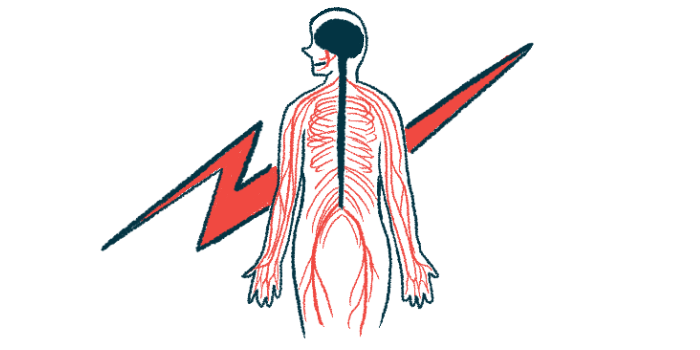Variants in PSAT1 Gene Linked to CMT for 1st Time in Two Teenagers
These variants usually affect central nervous system, not peripheral nerves
Written by |

Inherited variants in the PSAT1 gene caused Charcot-Marie-Tooth (CMT) disease in two adolescents, as detailed in a case study and reportedly for a first time.
These cases are unusual, given that PSAT1 variants are known to cause severe abnormalities in the central nervous system (CNS), or the brain and spinal cord. CMT, in contrast, affects peripheral nerves that extend from the CNS into the body and limbs.
While the teenagers also experienced ichthyosis, marked by dry, thickened, and scaly skin, no signs of CNS involvement were evident.
Patients’ motor and sensory function improved, and their ichthyosis eased, after oral supplementation with the amino acid serine, a protein building block.
PSAT1 variants not previously a known cause of Charcot-Marie-Tooth disease
The case study, “Pathogenic PSAT1 variants and autosomal recessive axonal Charcot–Marie–Tooth disease with ichthyosis,” was published in the journal Pediatric Neurology.
CMT is a rare disorder affecting peripheral nerves, which control motor function (movement) and sensation. Different types of CMT are caused by mutations in several genes that either damage nerve fibers, referred to as axonal CMT, or myelin, the fat-rich layer that insulates the nerve fibers, referred to as demyelinating CMT.
Phosphoserine aminotransferase (PSAT) is an enzyme involved in the production of the amino acid serine. Mutations in the PSAT1 gene, which encodes the PSAT enzyme, lead to serine deficiency and severe abnormalities in the CNS. PSAT1-related damage to peripheral nerves was reported recently, but with CNS involvement.
Researchers in China now described the cases of two unrelated adolescents who carried disease-causing PSAT1 mutations but had no CNS involvement, and motor and sensory nerve damage matching axonal CMT.
A 17-year-old boy was born into an unaffected family. Since infancy, he had dry, scaly skin and was diagnosed with ichthyosis, which commonly occurs in people with serine deficiency, the researchers noted.
By age 15, he began to experience walking difficulties due to progressive muscle weakness and wasting in the lower limbs, which eventually spread to his forearms and hands. At 16, he started to use crutches due to foot deformities and began losing sensation in his limbs. At 17, he was unable to walk or manipulate objects with his hands due to a loss of strength.
Although cognitive assessments were in the normal range, electromyography, given to assess the muscles and the nerves that control them, indicated damage. Nerve conduction studies, which measured electrical signals, revealed absent or reduced responses in his peripheral nerves, while ultrasound assessment found enlarged nerves, and muscle MRI showed fatty infiltration, a sign of muscle wasting.
Both teens respond well to treatment with serine supplements
Blood tests showed serine levels were in the normal range, but the boy had elevated markers suggesting malnutrition. A nerve biopsy showed reduced density of myelinated nerve fibers, and electron microscopy revealed signs of axon damage and death.
Genetic analysis identified a variant called c.43G>C in both PSAT1 gene copies (G stands for guanine and C for cytosine, both DNA building blocks). His parents carried the same variant in one of their two PSAT1 gene copies, and were unaffected carriers. According to the researchers, this variant has been found in people with serine deficiency with peripheral nerve damage; in yeast, it leads to a loss of PSAT enzyme function.
His ichthyosis was successfully treated with standard care, and at age 18 the boy began taking oral serine supplements. After one year of treatment, he reported increased sensation and improved muscle strength in his lower legs.
The other patient was a 14-year-old girl also born into an unaffected family. By the age of 5, signs of ichthyosis appeared, which spread across her body and worsened with sun exposure. At 12, she could not stand on the tips of her toes, and by 14, she had difficulty walking due to a loss of muscle strength. Clinicians also found reduced sensation to vibrations and pain in both feet.
Similarly, her cognitive tests were normal, while nerve conduction studies showed impaired electrical signal strength in peripheral nerves of the arms and legs. Ultrasound detected nerve enlargement and mild fatty infiltration in the calf muscles. Routine blood tests were normal, including for serine levels, but she also showed signs of malnutrition. Reduced density of myelinated nerve fibers and evidence of axon damage also were observed.
Like the boy, this patient carried the same c.43G>C variant in one of her PSAT1 gene copies, but unlike the boy, she had a c.112A>C variant in her second PSAT1 gene copy (A stands for adenine, another DNA building block). Her mother was an unaffected carrier of the c.43G>C variant, and her father of the c.112A>C variant.
She also was given serine supplements, which markedly eased her ichthyosis after 10 days of treatment. After 10 months, the strength in all of her muscles appeared to normalize, although her serine levels were elevated due to treatment.
Serine supplementation was well-tolerated in both patients.
The researchers recommended serine testing and assessments of skin, sensory, and motor function, monitoring for side effects, and exploring serine dosages.
“Pathogenic PSAT1 variants can cause axonal CMT disease, which progressively affect motor and sensory nerves of the peripheral nervous systems,” the scientists concluded. “This is the first report of PSAT1-related axonal CMT without associated CNS malformations, expanding the clinical and genetic spectrum of PSAT1-associated diseases.”





